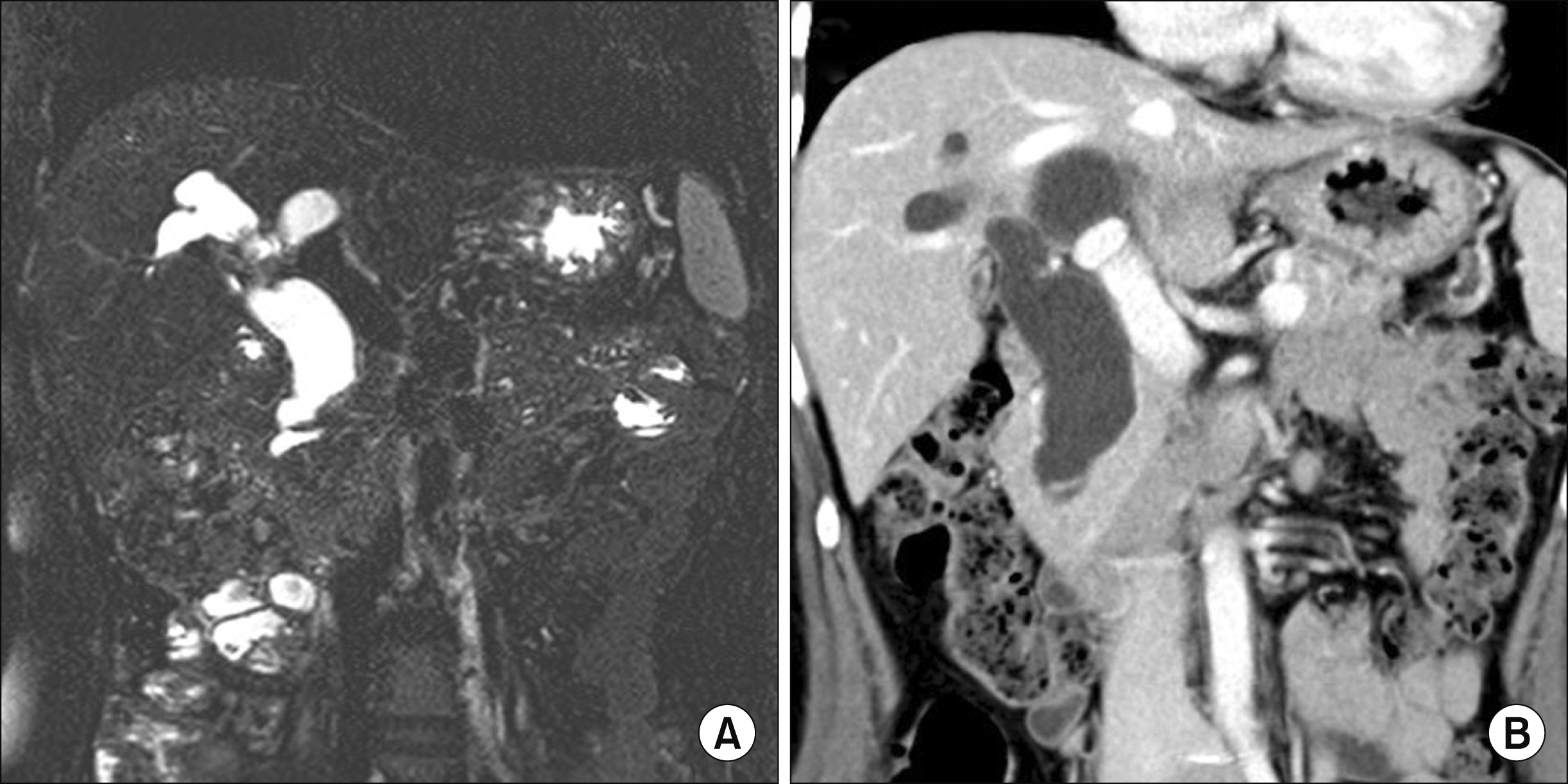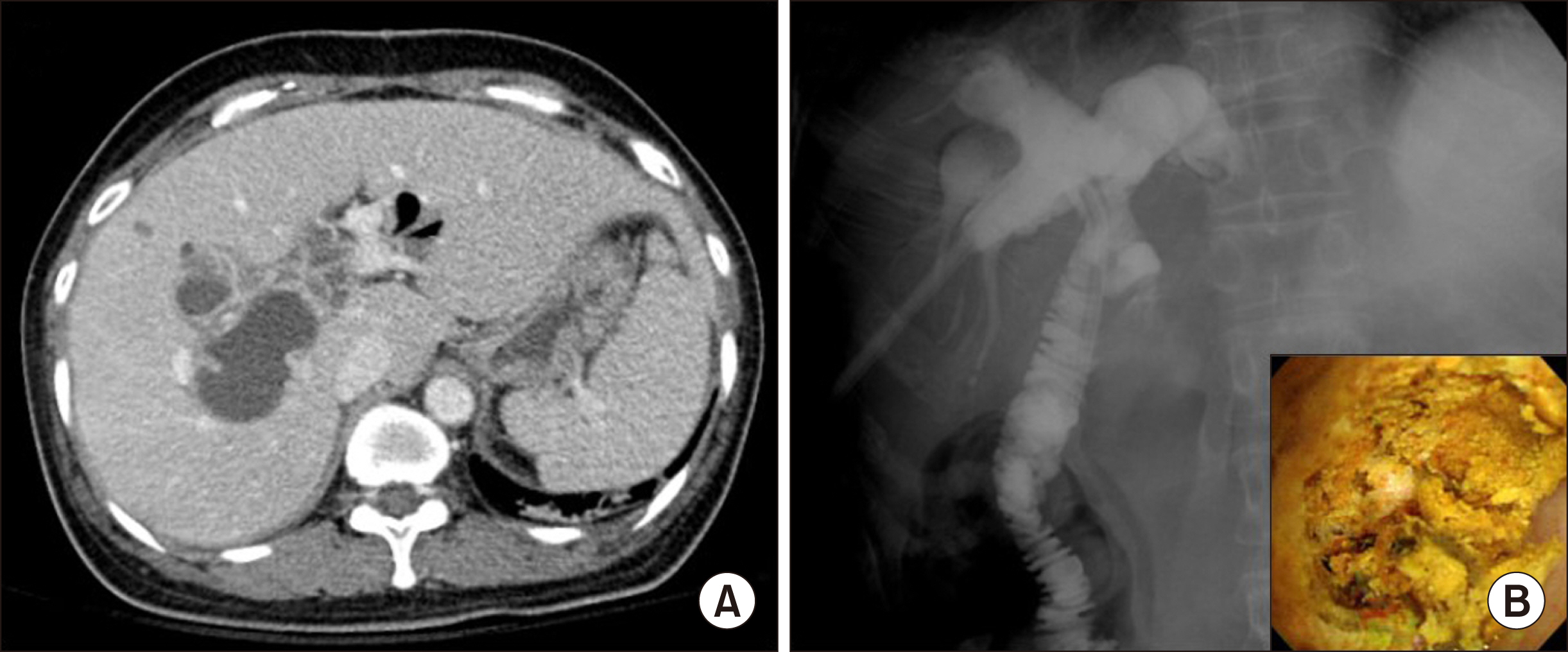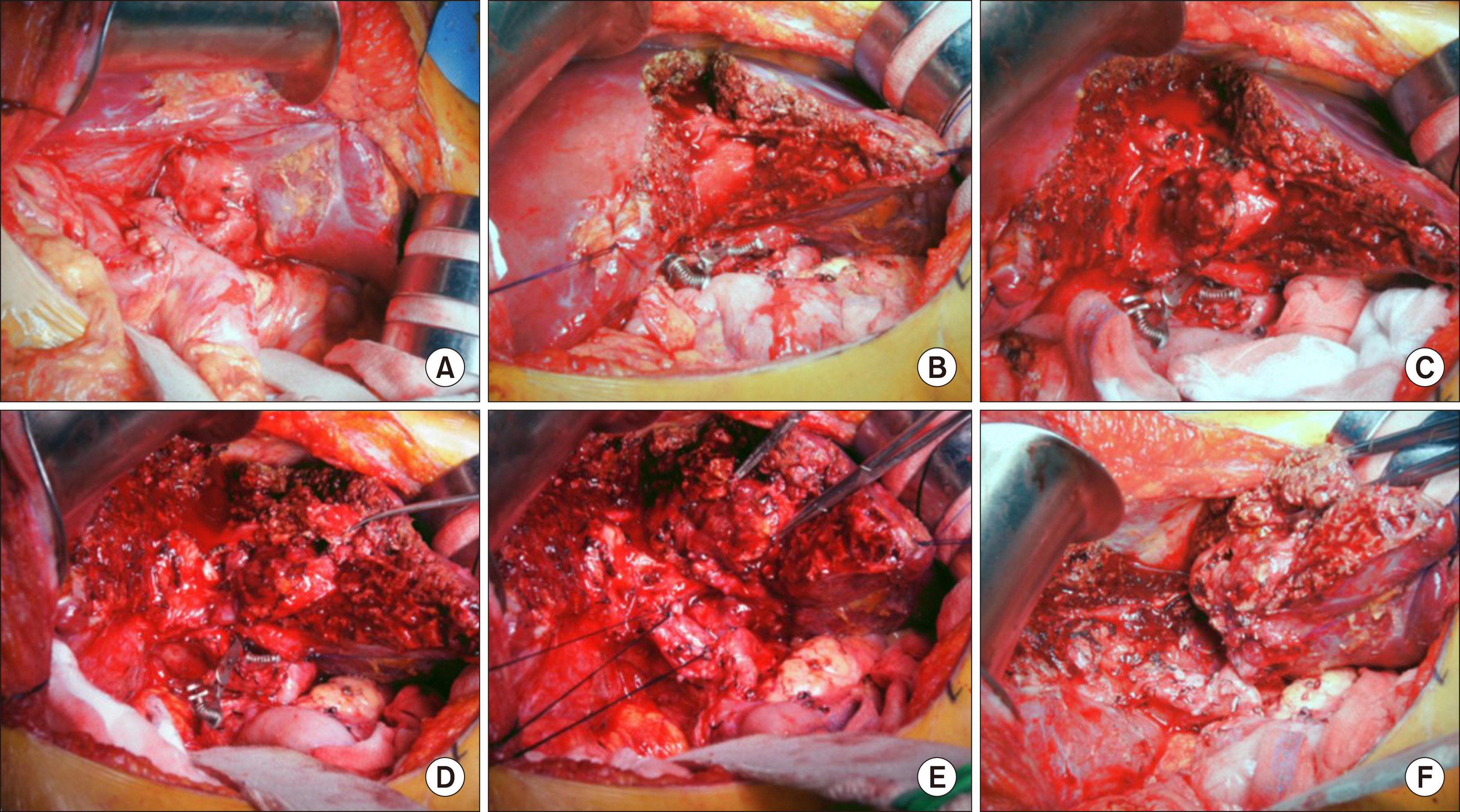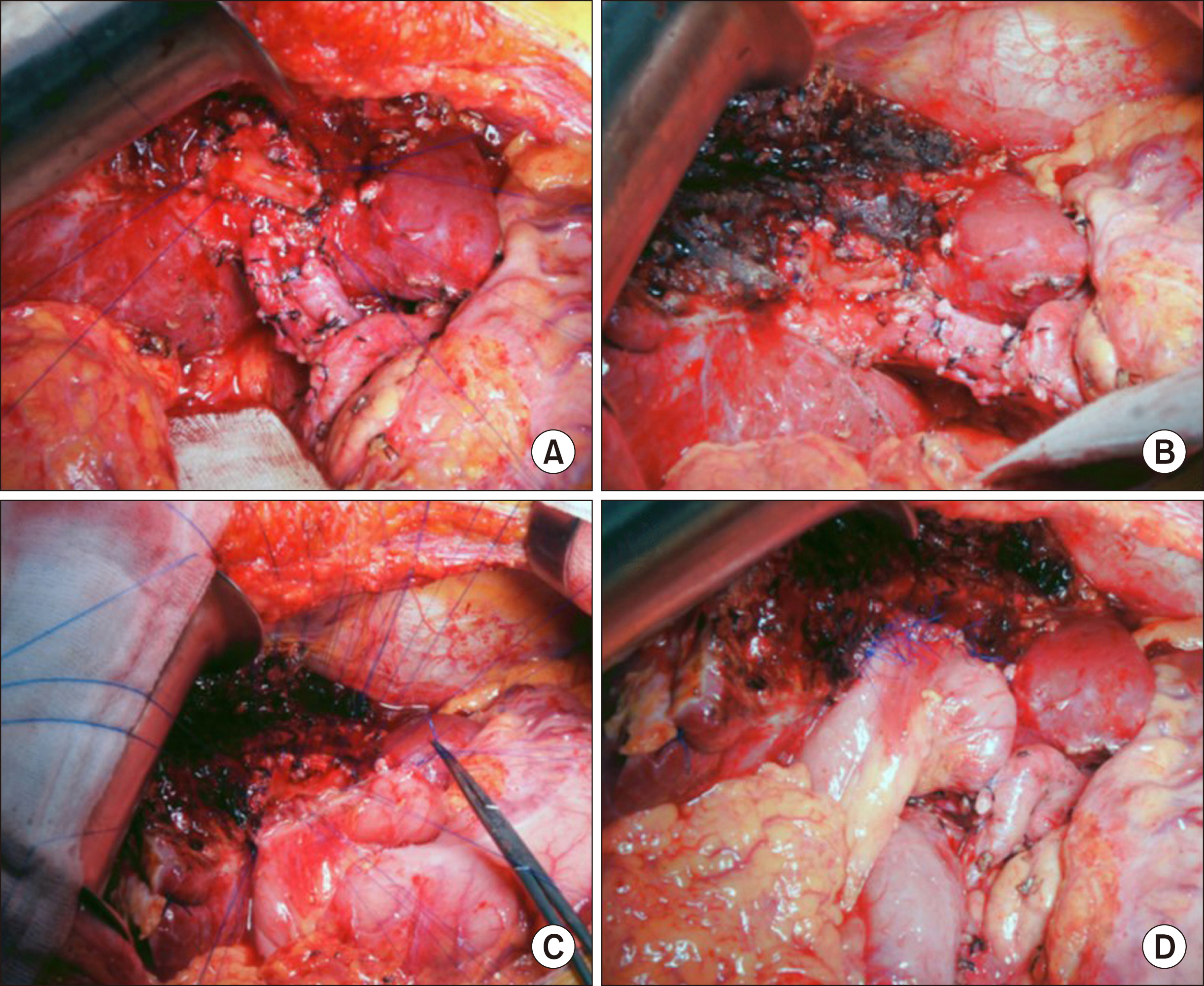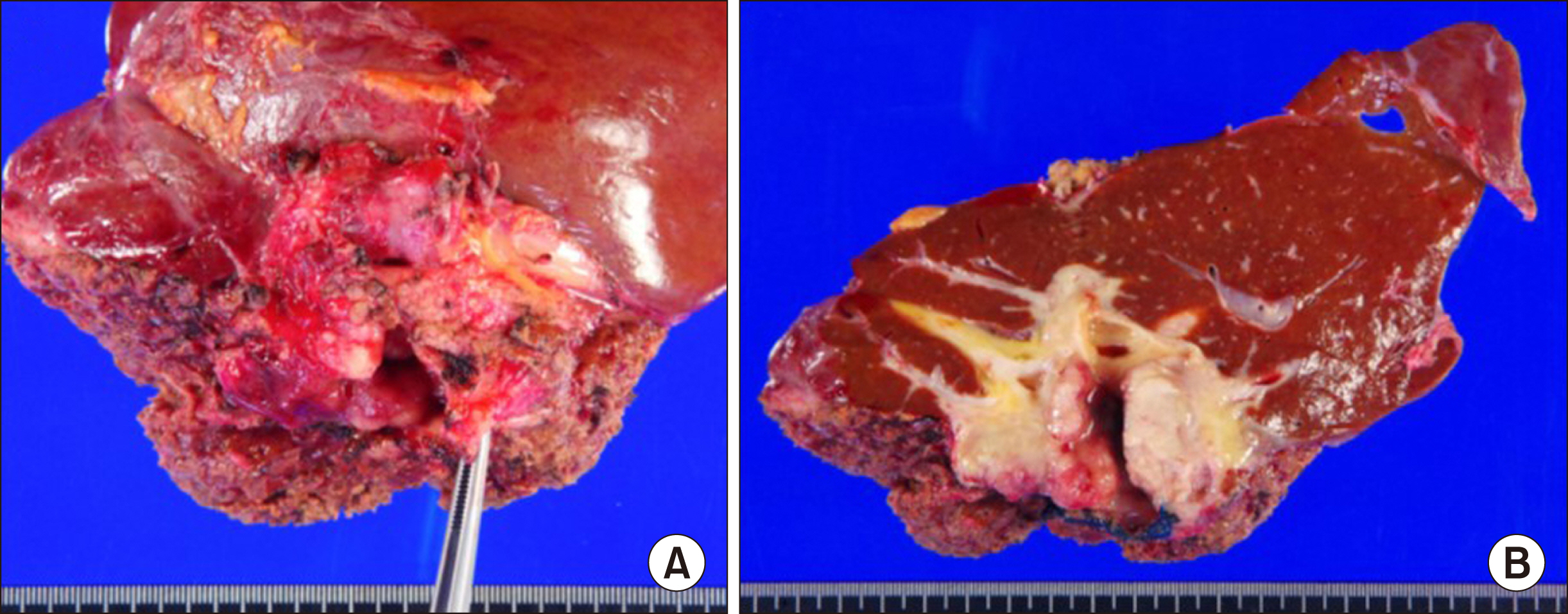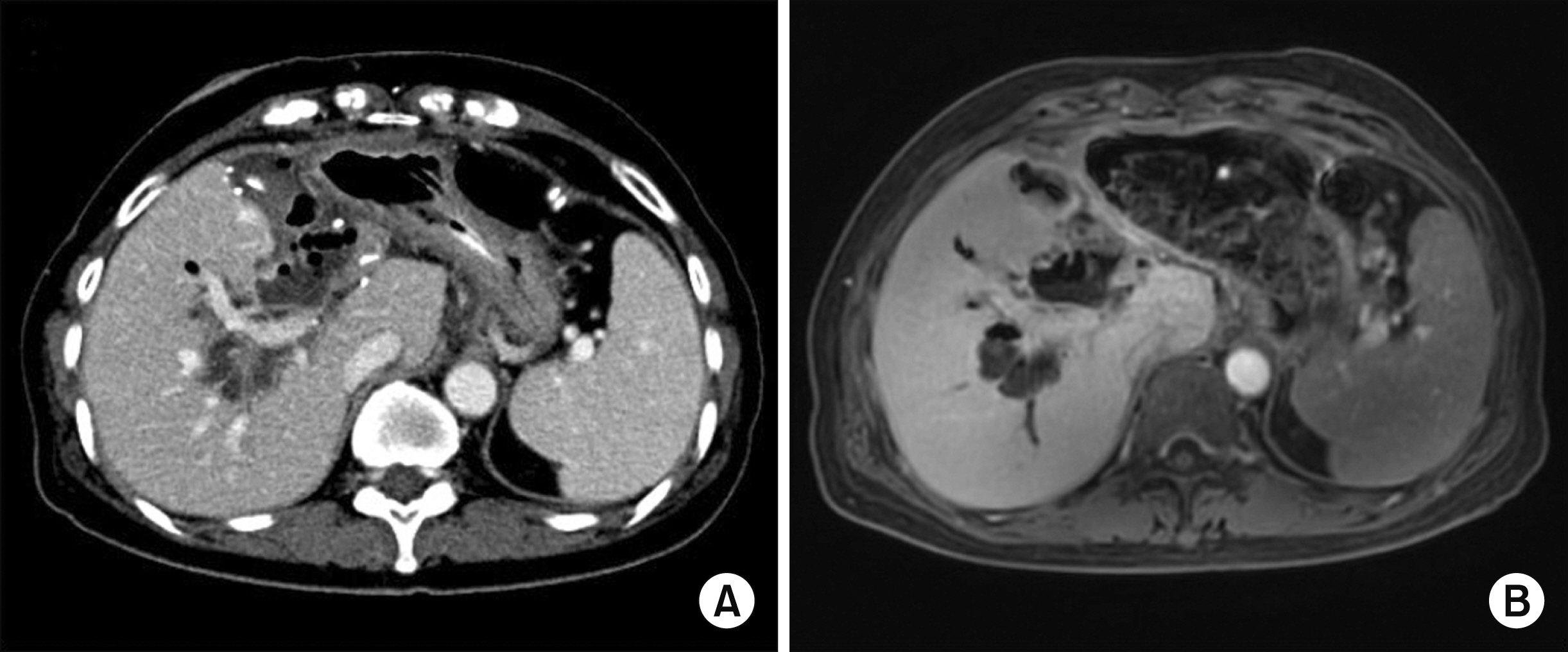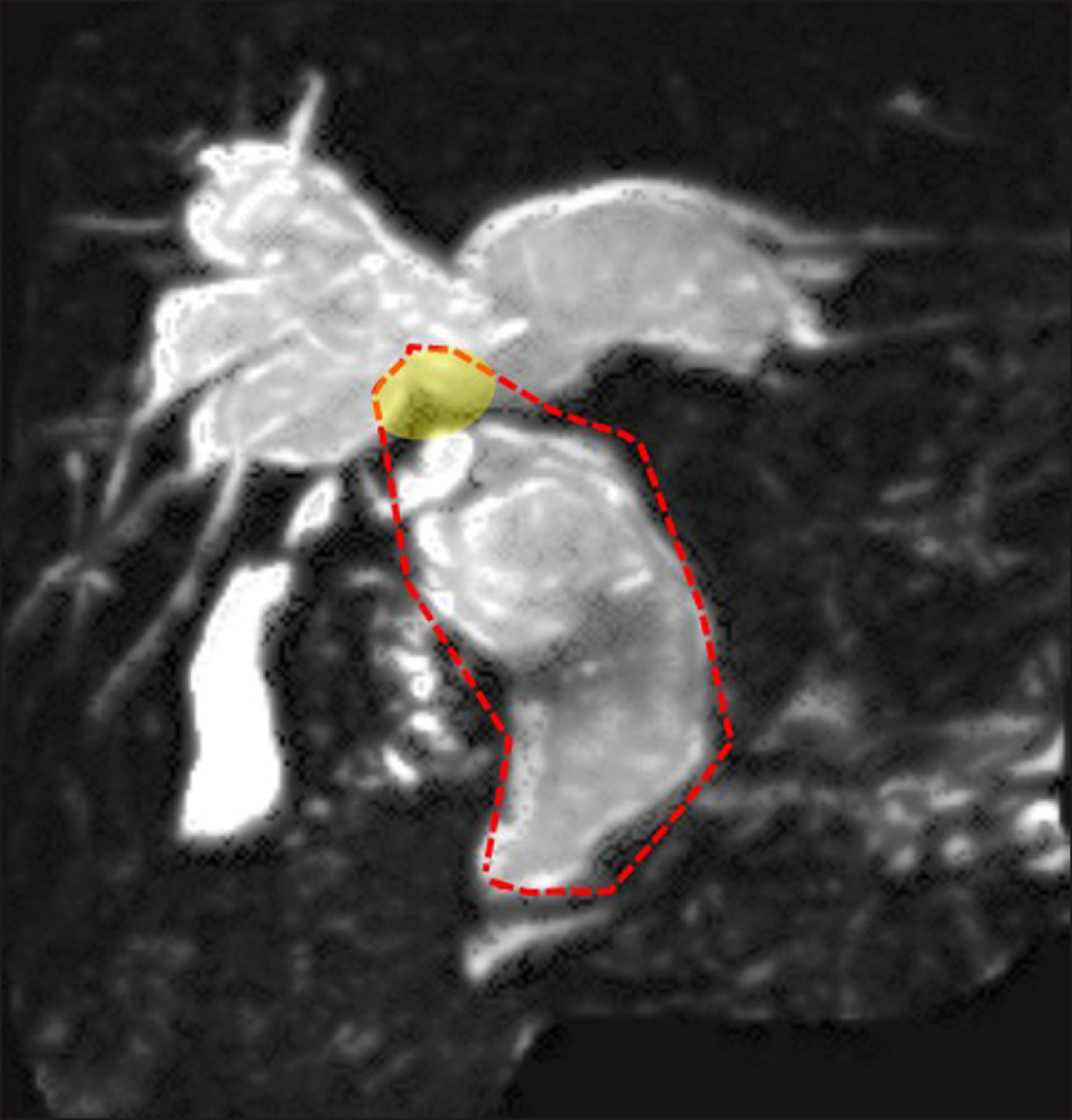Ann Hepatobiliary Pancreat Surg.
2020 Aug;24(3):366-372. 10.14701/ahbps.2020.24.3.366.
Development of intrahepatic cholangiocarcinoma at the remnant intrahepatic cyst portion 10 years after resection of type IV choledochal cyst
- Affiliations
-
- 1Department of Surgery, Asan Medical Center, University of Ulsan College of Medicine, Seoul, Korea
- KMID: 2505353
- DOI: http://doi.org/10.14701/ahbps.2020.24.3.366
Abstract
- Complete resection of Todani type IV choledochal cyst (CC) is not possible, because the intrahepatic portion is not resectable. We present a case of intrahepatic cholangiocarcinoma that arose from the remnant CC portion that was located within the liver 10 years after resection. A 59-year-old female patient had undergone resection of type IV CC 10 years ago, leaving large remnant portions of CC at the liver and pancreas. Two and four years after resection of the extrahepatic CC, cholangitis with intrahepatic stones developed hence these episodes were treated with percutaneous transhepatic cholangioscopy. Ten years after the first operation, intrahepatic stones and a new mass were identified in follow-up imaging studies. Because the mass was identified as adenocarcinoma on biopsy, we performed left hepatectomy with redo hepaticojejunostomy. Pathologic examination showed a 4.5-cm-sized moderately differentiated adenocarcinoma arising from the remnant CC with lymph node metastasis. The patient recovered uneventfully and is currently undergoing adjuvant chemotherapy. Our case indicates that the remnant intrahepatic CC can undergo malignant transformation long after resection of CC. Since the intrahepatic CC portion in type IV CC is usually unresectable,wide hepaticojejunostomy and life-long observation with regular imaging study follow-up are highly recommended for prevention and early detection of malignant transformation.
Keyword
Figure
Reference
-
1. Fan F, Xu DP, Xiong ZX, Li HJ, Xin HB, Zhao H, et al. 2018; Clinical significance of intrapancreatic choledochal cyst excision in surgical management of type I choledochal cyst. J Int Med Res. 46:1221–1229. DOI: 10.1177/0300060517728598. PMID: 29322850. PMCID: PMC5972235.
Article2. Cho MJ, Hwang S, Lee YJ, Kim KH, Ahn CS, Moon DB, et al. 2011; Surgical experience of 204 cases of adult choledochal cyst disease over 14 years. World J Surg. 35:1094–1102. DOI: 10.1007/s00268-011-1009-7. PMID: 21360306.
Article3. Ng DW, Chiow AK, Poh WT, Tan SS. 2016; Metachronous cholangiocarcinoma 13 years post resection of choledochal cyst-is long-term follow-up useful? : a case study and review of the literature. Surg Case Rep. 2:60. DOI: 10.1186/s40792-016-0187-9. PMID: 27307284. PMCID: PMC4909682.
Article4. Shimamura K, Kurosaki I, Sato D, Takano K, Yokoyama N, Sato Y, et al. 2009; Intrahepatic cholangiocarcinoma arising 34 years after excision of a type IV-A congenital choledochal cyst: report of a case. Surg Today. 39:247–251. DOI: 10.1007/s00595-008-3825-4. PMID: 19280286.
Article5. Kumamoto T, Tanaka K, Takeda K, Nojiri K, Mori R, Taniguchi K, et al. 2014; Intrahepatic cholangiocarcinoma arising 28 years after excision of a type IV-A congenital choledochal cyst: report of a case. Surg Today. 44:354–358. DOI: 10.1007/s00595-012-0387-2. PMID: 23090140. PMCID: PMC3898144.6. Goto N, Yasuda I, Uematsu T, Kanemura N, Takao S, Ando K, et al. 2001; Intrahepatic cholangiocarcinoma arising 10 years after the excision of congenital extrahepatic biliary dilation. J Gastroenterol. 36:856–862. DOI: 10.1007/s005350170010. PMID: 11777216.
Article7. Nishiyama R, Shinoda M, Tanabe M, Masugi Y, Ueno A, Hibi T, et al. 2011; Intrahepatic cholangiocarcinoma arising 33 years after excision of a choledochal cyst: report of a case. Int Surg. 96:320–325. DOI: 10.9738/CC82.1. PMID: 22808614.8. Yoshikawa K, Yoshida K, Shirai Y, Sato N, Kashima Y, Coutinho DS, et al. 1986; A case of carcinoma arising in the intrapancreatic terminal choledochus 12 years after primary excision of a giant choledochal cyst. Am J Gastroenterol. 81:378–384. PMID: 3706253.9. Suzuki S, Amao K, Harada N, Tanaka S, Hayashi T, Suzuki M, et al. 2004; A case of intrahepatic cholangiocarcinoma arising 26 years after excision of congenital biliary dilatation. Jpn J Gastroenterol Surg. 37:416–421. DOI: 10.5833/jjgs.37.416.
Article10. Oh SY, Kwon JH, Hwang S. 2019; Development of adenocarcinoma at the remnant intrapancreatic cyst 16 years after resection of the choledochal cyst. Ann Hepatobiliary Pancreat Surg. 23:192–196. DOI: 10.14701/ahbps.2019.23.2.192. PMID: 31225424. PMCID: PMC6558127.
Article11. Ando H, Kaneko K, Ito T, Watanabe Y, Seo T, Harada T, et al. 1996; Complete excision of the intrapancreatic portion of choledochal cysts. J Am Coll Surg. 183:317–321. PMID: 8843259.12. Choi JU, Hwang S, Chung YK. 2020; Management of intractable pancreatic leak from iatrogenic pancreatic duct injury following resection of choledochal cyst in an adult patient. Ann Hepatobiliary Pancreat Surg. 24:228–233. DOI: 10.14701/ahbps.2020.24.2.228. PMID: 32457272. PMCID: PMC7271105.
Article13. Ohashi T, Wakai T, Kubota M, Matsuda Y, Arai Y, Ohyama T, et al. 2013; Risk of subsequent biliary malignancy in patients undergoing cyst excision for congenital choledochal cysts. J Gastroenterol Hepatol. 28:243–247. DOI: 10.1111/j.1440-1746.2012.07260.x. PMID: 22989043. PMCID: PMC3816325.
Article14. Thistlethwaite JR, Horwitz A. 1967; Choledochal cyst followed by carcinoma of the hepatic duct. South Med J. 60:872–874. DOI: 10.1097/00007611-196708000-00017. PMID: 6036658.
Article15. Gallagher PJ, Millis RR, Mitchinson MJ. 1972; Congenital dilatation of the intrahepatic bile ducts with cholangiocarcinoma. J Clin Pathol. 25:804–808. DOI: 10.1136/jcp.25.9.804. PMID: 4343747. PMCID: PMC477515.
Article16. Chaudhuri PK, Chaudhuri B, Schuler JJ, Nyhus LM. 1982; Carcinoma associated with congenital cystic dilation of bile ducts. Arch Surg. 117:1349–1351. DOI: 10.1001/archsurg.1982.01380340067016. PMID: 7125900.
Article17. Rossi RL, Silverman ML, Braasch JW, Munson JL, ReMine SG. 1987; Carcinomas arising in cystic conditions of the bile ducts. A clinical and pathologic study. Ann Surg. 205:377–384. DOI: 10.1097/00000658-198704000-00006. PMID: 3566373. PMCID: PMC1492743.18. Young WT, Thomas GV, Blethyn AJ, Lawrie BW. 1992; Choledochal cyst and congenital anomalies of the pancreatico-biliary junction: the clinical findings, radiology and outcome in nine cases. Br J Radiol. 65:33–38. DOI: 10.1259/0007-1285-65-769-33. PMID: 1336694.
Article19. Kobayashi S, Asano T, Yamasaki M, Kenmochi T, Nakagohri T, Ochiai T. 1999; Risk of bile duct carcinogenesis after excision of extrahepatic bile ducts in pancreaticobiliary maljunction. Surgery. 126:939–944. DOI: 10.1016/S0039-6060(99)70036-X. PMID: 10568195.
Article20. Koike M, Yasui K, Shimizu Y, Kodera Y, Hirai T, Morimoto T, et al. 2002; Carcinoma of the hepatic hilus developing 21 years after biliary diversion for choledochal cyst: a case report. Hepatogastroenterology. 49:1216–1220. PMID: 12239908.21. Ono S, Sakai K, Kimura O, Iwai N. 2008; Development of bile duct cancer in a 26-year-old man after resection of infantile choledochal cyst. J Pediatr Surg. 43:E17–E19. DOI: 10.1016/j.jpedsurg.2008.01.073. PMID: 18558159.
Article
- Full Text Links
- Actions
-
Cited
- CITED
-
- Close
- Share
- Similar articles
-
- Type IV-A Choledochal Cyst with Intrahepatic Bile Duct Stricture
- Multiple stone formation in a remnant choledochal cyst
- A Case of Intrahepatic Cholangiocarcinoma Associated with Type IV Choledochal Cyst
- Development of Cholangiocarcinoma Arising from Remnant Intrapancreatic Cyst 15 Years after Choledochal Cyst Excision
- A Case Report of an Unusual Type of Choledochal Cyst with Choledocholithiasis: Saccular Dilatation of the Confluent Portion of Both Intrahepatic Ducts

